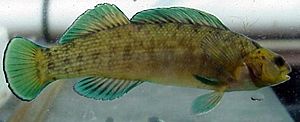Boulder darter facts for kids
Quick facts for kids Boulder darter |
|
|---|---|
 |
|
| Conservation status | |
| Scientific classification | |
| Synonyms | |
|
The boulder darter (Etheostoma wapiti) is a small freshwater fish. It belongs to a group of fish called darters. These fish are part of the perch family, which also includes perches, ruffes, and pikeperches.
This special fish lives only in parts of Alabama and Tennessee in the United States. You can find it in the Elk River system and Shoal Creek. Boulder darters like small rivers and fast-moving streams. They prefer water that is at least 2 feet (0.6 meters) deep with lots of rocks or boulders.
Boulder darters eat tiny water insects. Not much is known about their daily lives. Sadly, their numbers are decreasing. This is because of things like too much dirt (silt) in the water and dams blocking their rivers. Because of these threats, the International Union for the Conservation of Nature says the boulder darter is a "vulnerable" species. This means it could become endangered if we don't protect it.
What Does It Look Like?
The boulder darter is a small fish. It can grow up to about 3 inches (7.6 centimeters) long. Its body color is usually olive green to gray.
Scientists believe these fish probably lay their eggs in the spring. This usually happens in April and May.
Where Do Boulder Darters Live?
The boulder darter lives only in the Elk River and some of its larger streams. In the Elk River, you can find them from Fayetteville down to just above the Wheeler Reservoir. They also live in the lower parts of Richland Creek and near the mouth of Indian Creek. These places are in south-central Tennessee and northern Alabama.
Boulder darters love fast-flowing streams. They need water that is at least 2 feet (0.6 meters) deep. The bottom of these streams must be rocky or have many boulders. They also need very clean water to survive. Their main food source is believed to be young water insects.
Why Are They Vulnerable?
The boulder darter was once listed as an endangered species in the U.S. in 1988. This means it was in great danger of disappearing forever. Many human activities have caused them to vanish from most of the places they used to live.
For example, cold water released from the Tims Ford Reservoir likely made the upper Elk River too cold for them. Also, the Wilson Dam caused flooding in parts of Shoal Creek. Pollution from factories in other parts of the stream also hurt the fish. The last time a boulder darter was seen in Shoal Creek was in the 1880s.
The International Union for the Conservation of Nature (IUCN) now lists the boulder darter as "vulnerable." This means it's still at risk. They suggest that we need to keep watching their habitats and populations. This will help protect these special fish and the places they live.
See also
 In Spanish: Etheostoma wapiti para niños
In Spanish: Etheostoma wapiti para niños


